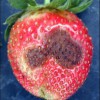 Florida’s producers use fungicides to manage anthracnose and botrytis fruit rot diseases, which find favorable growth conditions in Florida’s climate and can reduce strawberry yields and profits. The Strawberry Advisory System (SAS) uses information about weather conditions and user-entered information about past fungicide applications to evaluate the potential spread of these diseases in strawberry fields. If the risk of disease spread is low, no fungicide application is recommended, allowing producers to save on fungicide application costs. In this study, we summarize the results of a 2012/2013 survey of strawberry producers, and focus on the questions, How significant is the impact of anthracnose and botrytis on Florida strawberry producers’ yields? What are the typical fungicide application frequencies used by the producers? What percent of strawberry producers use SAS? and Are there any effects of SAS subscription on producers’ fungicide application? This 4-page fact sheet was written by Tatiana Borisova, Zhengfei Guan, Ekaterina Vorotnikova, Natalia Peres, and John VanSickle, and published by the UF Department of Food and Resource Economics, October 2014.
Florida’s producers use fungicides to manage anthracnose and botrytis fruit rot diseases, which find favorable growth conditions in Florida’s climate and can reduce strawberry yields and profits. The Strawberry Advisory System (SAS) uses information about weather conditions and user-entered information about past fungicide applications to evaluate the potential spread of these diseases in strawberry fields. If the risk of disease spread is low, no fungicide application is recommended, allowing producers to save on fungicide application costs. In this study, we summarize the results of a 2012/2013 survey of strawberry producers, and focus on the questions, How significant is the impact of anthracnose and botrytis on Florida strawberry producers’ yields? What are the typical fungicide application frequencies used by the producers? What percent of strawberry producers use SAS? and Are there any effects of SAS subscription on producers’ fungicide application? This 4-page fact sheet was written by Tatiana Borisova, Zhengfei Guan, Ekaterina Vorotnikova, Natalia Peres, and John VanSickle, and published by the UF Department of Food and Resource Economics, October 2014.
http://edis.ifas.ufl.edu/fe957
Tag: John J. VanSickle
FE817 Production Budget for Tomatoes in the Manatee-Ruskin Area of Florida
FE817, a 6-page fact sheet by John VanSickle, Scott Smith, and Eugene McAvoy, highlights tomato production in the Manatee-Ruskin Area, with a per-acre composite budget for a representative grower. Includes references. Published by the UF Department of Food and Resource Economics, December 2009.
http://edis.ifas.ufl.edu/FE817
FE810 Production Budget for Bell Peppers in Southwest Florida
FE810, a 4-page fact sheet by John VanSickle, Scott Smith, and Eugene McAvoy, provides an overview of bell pepper production practices for Southwest Florida producers, including a per-acre composite budget breaking down the specific cost components. Includes references. Published by the UF Department of Food and Resource Economics, December 2009.
http://edis.ifas.ufl.edu/FE810
FE809 Production Budget for Bell Peppers in Palm Beach County, Florida
FE809, a 4-page fact sheet by John VanSickle, Scott Smith, and Eugene McAvoy, provides an overview of bell pepper production practices for Palm Beach County producers, including a per-acre composite budget breaking down the specific cost components. Includes references. Published by the UF Department of Food and Resource Economics, December 2009.
http://edis.ifas.ufl.edu/FE809
FE818 Production Budget for Tomatoes in Southwest Florida
FE818, a 5-page fact sheet by John VanSickle, Scott Smith, and Eugene McAvoy, provides producers with brief overview of tomato industry and production practices in southwest Florida, with a per-acre composite budget for a representative grower. Includes references. Published by the UF Department of Food and Resource Economics, December 2009.
http://edis.ifas.ufl.edu/FE818
FE795 Impacts of EPA Proposed Buffer-Zone Restrictions on Profitability of Florida Strawberry Growers
FE795, a 5-page fact sheet by John J. VanSickle, Scott Smith, and Richard Weldon, reports the results of a study to characterize the impact of the proposed buffer-zone restriction on the economic returns to Florida strawberry-growers. Includes references. Published by the UF Department of Food and Resource Economics, March 2009.
http://edis.ifas.ufl.edu/FE795
FE794 Impacts of EPA Proposed Buffer-Zone Restrictions on Profitability of North Florida Potato Growers
FE794, a 4-page fact sheet by John J. VanSickle, Scott Smith, and Richard Weldon, reports the results of a study to characterize the impact of the proposed buffer-zone restriction on the economic returns to Florida potato-growers. Includes references. Published by the UF Department of Food and Resource Economics, March 2009.
http://edis.ifas.ufl.edu/FE794
FE749 U.S. Production Trends and the Impact of the Florida Fresh Market Tomato Industry to the Economy of Florida
FE749, a 6-page fact sheet by John J. VanSickle and Alan W. Hodges, describes trends in tomato production and provides estimates for the total regional impacts of the Florida tomato industry using IMPLAN input output modeling system. Includes references. Published by the UF Department of Food and Resource Economics, September 2008.
http://edis.ifas.ufl.edu/FE749